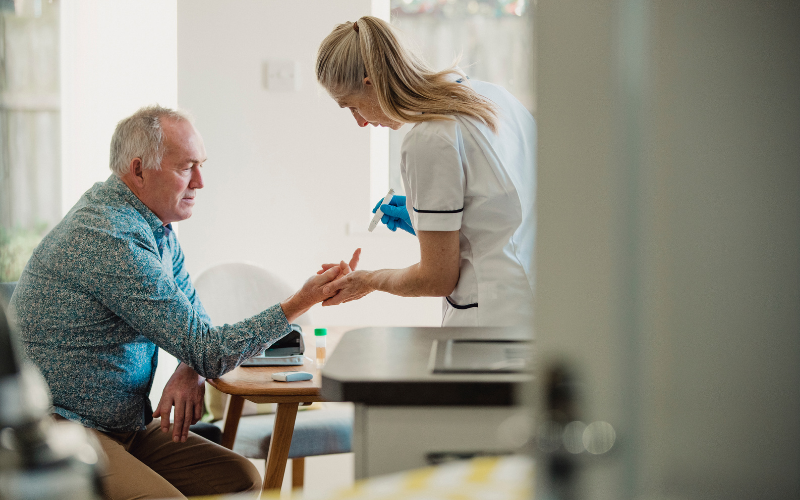The Promise of Bioelectronic Medicine in Diabetes Treatment

Are we moving closer to the day when diabetes no longer requires insulin injections, glucose testing, and medication treatments?
Recent findings suggest that Bioelectronic medicines can have a major impact on various health issues. It can treat diseases like diabetes with new solutions.
Diabetes is a serious problem for millions of people around the globe. Plus, there are very few drugs that lower insulin levels, and they often cause side effects. As a diabetic, over the years, I’ve struggled with skin rash, upset stomach, weight gain, bloating, and diarrhea.
Bioelectronic medicine can change that. It could provide a significant milestone in the field of diabetes care.
Bioelectronic medicine is capable of exchanging and modulating neural signaling patterns. This is a new field that combines biomedical engineering, neuroscience, and molecular medicine. So, I decided to dig a little deeper. Here is how electroceuticals can help with diabetes care.
What Is Bioelectronic Medicine?
Bioelectronic medicine is the study of innovative approaches for treating chronic conditions. Such as arthritis, irritable bowel syndrome (IBS), and diabetes. It focuses on using devices to actively target and correct dysfunctions in the nervous system. These dysfunctions are thought to play a significant role in the development of these diseases.
Bioelectric medicine uses unique molecular processes of neural regulation and the latest technological advancements to create new methods for diagnosing and treating diseases.
This field is fueled by groundbreaking research. Bioelectronic approaches have already shown success in treating conditions. Mainly neurodegenerative diseases, inflammatory bowel disease, rheumatoid arthritis, obesity, diabetes, and other ailments.
How Can Bioelectronic Medicine Be Used in Diabetes Treatment?
For quite some time now, we’ve been utilizing implants to generate electrical activity within the body. The pacemaker was the first such device. And 60 years ago, the implants were quite large and bulky. However, there have been significant advancements in electronics since then.
The next generation of implantable devices can be incredibly small. They could be capable of interconnecting with each other. These miniature devices collaborate, exchange data, and record signals from our bodies to create customized treatments.
This approach is similar to adjusting drug dosages for specific therapies, explained Dr. Vasiliki Giagka in a blog for the Fraunhofer Institute for Reliability and Microintegration IZM.
To minimize side effects, these devices are implanted near the nerves. In particular, conditions like diabetes, Parkinson's disease, and asthma can be effectively treated through these procedures. And there is significant potential to address numerous other diseases as well.
What Does Research Say?
According to a recent study, bioelectronic medicine takes advantage of the neural innervation of all our organs. It allows for electrical interaction with peripheral nerves as a possible route for diagnosing and treating conditions like diabetes.
We already know that the nervous system plays a vital role in maintaining proper control of glucose levels in our bodies. This understanding has sparked new research into the potential of bioelectronic medicine to enhance glucose management for individuals with diabetes.
Research was meant to find a way to:
- regulate the speed of food digestion,
- increase the body's responsiveness to insulin,
- and balance the production of pancreatic hormones.
As a result, scientists are developing innovative closed-loop strategies to create safe and effective communication with the nervous system, specifically targeting the organs involved.
This breakthrough is valuable for chronic conditions like diabetes, as closed-loop bioelectronic medicine offers the promise of personalized, real-time, and self-regulating treatments that adapt to each patient's needs.
I also found another study that reported similar results. To effectively apply bioelectronic medicine outside the laboratory setting, it is crucial to employ focused neuromodulatory techniques. Targeted stimulation methods enable us to understand the mechanisms that can be beneficial for patients while minimizing any unwanted effects.
But, more research is necessary to understand the full extent of this type of medicine. In preclinical studies, it is necessary to conduct experiments using models that closely resemble the neuroanatomy and disease conditions of humans.
When choosing neural interfaces, it is important to opt for those that can stimulate nerves with minimal invasiveness while ensuring specificity.
What Can We Expect?
The field of bioelectronic medicine is rapidly expanding. Technological breakthroughs are driving the development of smaller and less intrusive devices. Companies are estimated to introduce new applications to the market in the coming years.
Statistics show that the bioelectric medicine market size is predicted to reach $37.2 Billion, with a CAGR of 6.4% by 2032.
There are some notable advantages of this technology that we can expect. One of the biggest perks is that we won’t be that dependent on medications, which tend to trigger adverse reactions.
Unlike drugs that often have a systemic effect on the entire body, bioelectronic devices allow for targeted and localized treatment of specific body parts or organs. The goal of bioelectronic medicine is to administer treatment directly to the intended organ, focusing solely on that area. It aims to restructure damaged neural pathways. This can help restore nerve functionality.
Dr. Thomas Deering, chief of the Arrhythmia Center, stated that countless people already rely on bioelectronic medicine. But we are only just starting to imagine the vast array of potential it can have.
As the field continues to grow and advance, it holds the capacity to meet important gaps in medical care. It can provide significant advantages for various groups of patients with unmet needs.
GE Research, for example, is working on using a non-invasive ultrasound technique for promoting nerve features. This technology is supposed to target organs very precisely. This method uses the organization and natural hierarchical structure of the nervous system.
The preliminary findings from the GE Research team indicate that more data is necessary to use ultrasound for peripheral neuromodulation. This would mean it is necessary for neuroscientists and ultrasound device engineers to collaborate.
Alongside their ongoing preclinical studies, the GE Research team is also working on a $2.9 million project with DARPA. The goal is to explore novel treatments for diabetes. They want to use similar non-invasive approaches with ultrasound to treat diabetes.
Conclusion
Bioelectronic medicine holds a lot of potential for diabetes treatment. It can improve diabetes management by offering innovative approaches for glucose control, improving insulin sensitivity, and devising personalized treatment options. Since this is an evolving field, I’m looking forward to the potential it can bring in the following years.



